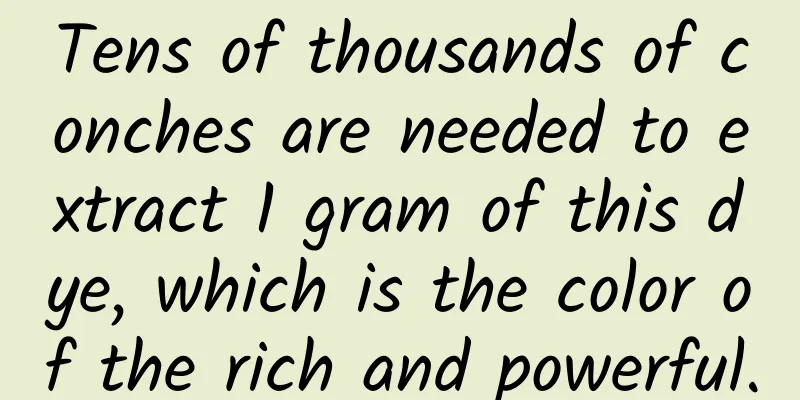Tens of thousands of conches are needed to extract 1 gram of this dye, which is the color of the rich and powerful.

|
Today we will talk about a dye that was once glorious but is now disdained by industrialization. In 1636, Peter Rubens, a famous and successful painter, was hired by the Spanish Habsburg dynasty to paint a hunting lodge for the royal family. However, he got a crucial detail wrong... Fortunately, the royal family did not ask him to rework and pay compensation, because the truth had been lost for hundreds of years by then. The name of this painting is "Hercules' Dog Discovers Purple Dye", which is based on a myth: One day, Hercules took his dog to express his love to the water nymph Taro, but the dog bit a shell while passing by the beach, and the blood from the shell dyed the dog's mouth purple. The fairy liked the purple very much and asked to make a robe of the same color. From then on, this shell became the source of purple dye. But this key shell in Rubens' painting is of the wrong species. You may ask, isn't it possible for a painter to paint a myth story however he wants? How can it be said to be a mistake? Although this story is a myth, the dye and the shells from which it comes are real. Not only that, it was the most valuable dye in the ancient world. It was once popular in the Mediterranean and became a symbol of the highest power in ancient Rome. It was more valuable than gold, so it can receive the supreme treatment of a mythical origin. Unfortunately, by the time of Rubens, the true origin of this dye had long been lost, and the painter must have painted it casually out of necessity; it would take a long time before its true appearance became known again. This dye is the legendary "Tyrian purple". Probably this color | colorhexa Purple, built a country In the 16th century BC (roughly corresponding to the early Shang Dynasty in China), residents in present-day Lebanon and Iraq set sail and headed westward. The Fertile Crescent on the eastern coast of the Mediterranean had exported many domesticated species such as wheat, barley, sheep, and cows in the previous thousands of years, and this time, their products did not disappoint - purple dye from shells. The dye was rich and durable, stronger than similar plant and mineral pigments. The ancient Greeks to the west called this group of Semitic people who mastered the manufacturing technology "Phoenicians", which means "people of the purple country". In the following centuries, the Phoenicians relied on their business acumen and enterprising spirit to establish footholds throughout the Mediterranean. To achieve this, the port city of Tyre played an indispensable role. Tyre, Lebanon | Wikimedia Commons The precious color that gave Phoenicia its name, known as "Tyrian purple," was produced here. There are still piles of snail shells scattered along the coast of Tyre. Tyrian purple is famous, but its raw materials are very humble. The two most common ones are the red-mouthed rock snail (Stramonita haemastoma) and the dye bone snail (Bolinus brandaris). They are distributed in warm seas and like to stay in rocky shallows. The former is only the size of a quail egg, while the latter can grow slightly longer than a chicken egg. (a) Red-mouthed rock snail, (c) Dye murex, (b) Murex trunculus, which can be used to make indigo and Tyrian purple | Reference 2 As carnivorous shellfish, when they catch prey or encounter danger, the subbranchial glands near their necks will secrete mucus to paralyze the opponent. The whitish mucus will stink in the air and change color: yellow, green, blue, and finally purple. According to Aristotle's "History of Animals", it is difficult to directly extract the glands of smaller shells, so craftsmen will break the whole thing; for larger conches, people choose to peel off the shell and then take out the part that secretes the original fluid. Of course, people can also stimulate shells to squeeze out mucus, but this non-killing method will dirty your hands. Depending on the type of shell and the dyeing method, blue, crimson and purple pigments can be produced, with the last being the most valuable. According to later Roman records, a conch shell could only contribute one drop of liquid. The production of dye was costly and the process was cumbersome, so a large number of Tyrians devoted themselves to it. In return, by the 3rd century AD, wool dyed with Tyrian purple was worth the same weight of gold. Purple is the color of power and nobility Unfortunately, the manufacturing technology of Tyrian purple has been lost, and we can only find the method of turning hypobranchial glands into high-grade dye from the records of the ancient Romans. In the 1st century AD, the ancient Roman Pliny the Elder recorded the steps of making dyes using red-mouthed rock snails. There is a specific season for catching these conches, and the best fishing season is when the Canis Major star is ascending or before spring, when the conches are at their largest. The glands should be soaked in salt for no more than three days. The fresher the snails are, the better the dye will be. The conches were boiled in tin containers, and every hundred amphora pots produced five hundred pounds of dye, during which the foam on the surface was scraped off from time to time, and the flesh and glands attached to the flesh were skimmed off. On about the tenth day, when the entire crucible becomes liquid, put a piece of wool in for trial dyeing. The amphora is characterized by a pointed bottom, narrow neck, and long body. | Wikimedia Commons But according to Pliny the Elder, the juice of the red-mouthed rock snail is of very inferior quality if used alone, and it is not Tyrian purple because it will fade. True Tyrian purple is a mixture of the red snail, which adds a crimson hue to the darker color of the murex, and the dye murex, which fixes the red snail's colorant to the fabric. The production method is to put the wool into the unboiled dye of the murex, and then soak it in the juice of the red-mouthed rock snail. The dyed color looks black at first glance, but it shines brightly in the light, and it is the most advanced Tyrian color. Mosaic depicting Tyrian purple on the robe of Byzantine Emperor Justinian I at the Church of San Vitale, Italy | Wikimedia Commons The ancient Romans were crazy about the color of Tyre, which was associated not only with money but also with power. According to the ancient Roman writer Cornelius Nepos, violet was the most popular color when he was a child, and a pound of fabric cost 100 silver coins, then Tarentum red, and finally Tyrian purple, which was dyed twice - 1,000 silver coins might not buy a pound of fabric. Over the next few centuries, the use of Tyrian purple in Rome became increasingly restricted to the upper classes of society, and by the 4th century AD, only the emperor himself was allowed to wear "true purple". Due to its association with power, Tyrian purple was expensive, which in turn limited its use. After the Fourth Crusade and the Turkish conquest of Constantinople, the method of making Tyrian purple was lost in the Western world because no one could afford such an expensive dye. By the time of Rubens in the 17th century, perhaps the color itself had become as much a legend as the Greek myth. The reappearance of Tyrian purple no longer has its former glory There are many legends about the reappearance of shell dye. A more real story happened in the UK. In 1684, after hearing that someone in Ireland was making a fortune from shell dyes, the Englishman William Cole began a long search on the coast of Bristol. His efforts paid off as he found local shells on the coast of England that could produce purple dye. In the sun, the shell juice turns dark purple after a few hours, and the dyed linen does not fade after 40 washes. Cole realized that this might be the long-lost Tyrian purple. He wrote a long letter about his experience and sent it to the Oxford Philosophical Society. The letter described in detail the reasons for his search for shells, the dyeing process, the washing process, his intention to present them to the king but the king unfortunately passed away, and was accompanied by a life-size illustration of the shells. Although Cole does not tell us the chemical nature of the color, the reappearance of shell dye gradually became known to the public. Illustrations for Cole's letter to Oxford. Figures 6 and 7 on the lower right are identified as dog snails (Nucella lapillus), which, along with the red-mouthed rock snail and the dye murex, belong to the Muricidae family and live in Europe and the northeastern Atlantic coast. | Reference 5 It was not until 1908 that Austrian chemist Paul Friedlander extracted 1.4 grams of pure Tyrian purple (C16H8Br2N2O2), a bromine-containing compound, from 12,000 dye murex shells. This extraction was not for commercial purposes, as the chemical industry at the time was already able to produce aniline purple, alizarin purple, azo dyes, and indigo of similar color to meet the needs of the public. Spending tens of thousands of shells to dye clothes purple was too uneconomical for people in the 20th century. Tyre violet dye molecular structure | Reference 2 To date, Tyrian purple has not been commercially synthesized, and modern industry is fully capable of producing similar shades in a cheaper way. There are no longer large numbers of snail collectors on the eastern coast of the Mediterranean. But apart from history, modern people have not let go of the dye murex (the larger kind), and it is serving humans in another way - on the dining table. References [1]. Philip Ball, The Bright Earth, translated by He Benguo, Yilin Press, first edition in 2018. [2].Indigo, woad, and Tyrian Purple: important vat dyes from antiquity to the present. https://www.sciencedirect.com/science/article/pii/0160932793900628 [3].The Minoan origin of Tyrian purple. https://www.researchgate.net/profile/Robert_Stieglitz/publication/261818482_The_Minoan_Origin_of_Tyrian_Purple/links/59ee19ed0f7e9b36957594cc/The-Minoan-Origin-of-Tyrian-Purple.pdf [4].Indigo and Tyrian Purple – From Ancient Natural Dyes to Modern Organic Semiconductors. https://onlinelibrary.wiley.com/doi/full/10.1002/ijch.201100130 [5].A Letter from Mr William Cole of Bristol, to the Phil. Society of Oxford; Containing His Observations on the Purple Fish. https://www.jstor.org/stable/102202 [6].Pliny the Elder, The Natural History. John Bostock, MD, FRS, HT Riley, Esq., BA, Ed. http://www.perseus.tufts.edu/hopper/ Walker, DR (1976-78), The Metrology of the Roman Silver Coinage. Parts I to III. Author:vicko238 Editor: Fangorn, Iris An AI How can something dyed with shells taste as good as eating it? This article comes from Guokr and may not be reproduced without permission. If necessary, please contact [email protected] |
<<: Dumplings always "explode" in the pan? Maybe you need to brush up on your heat transfer skills.
>>: The end of a skier's career is a medal, but the end of your skiing career may be a hospital...
Recommend
Fun fact: Is it possible for humans to grow wings?
I have nothing to do today, so I want to talk to ...
Chengdu Tea Tasting has its own studio, the best tea tasting in the whole place
Reservation arrangements for Chengdu Tea Tasting ...
How to create user portraits and find accurate users?
Two nights ago, a young girl who had just started...
With TV games flooding the market, Huanzhong Technology's "Fibble" had over a thousand downloads on its first day of release?
The advent of the OTT era has provided an opportu...
Vodafone executive: Australia will have 5G by 2020
According to foreign media reports, Vodafone Aust...
SEO team building plan, how to build a SEO team?
Generally, friends who have been engaged in SEO f...
Equity Incentive and Equity Financing Solutions Class
Resource introduction of equity incentive and equ...
A set of pictures to understand Android, this foodie
If you have been to the Google headquarters in Mo...
Coupon Operation Guide: One coupon to attract new customers, promote activation, conversion, and recall
Coupons can play a good role in attracting new an...
Fainted in the toilet: 60% of Internet practitioners earn less than 6,000 yuan a month
[[134144]] "Working is so tiring, I don'...
CEO live streaming is not for selling goods!
More than 30 years ago, when Microsoft was promot...
How to plan an event from 0 to 1?
As a planner and operator, online activities are ...
Wall Street lowers Tesla stock price forecast: too much growth will eventually pay off
Elon Musk just announced that Model 3 will be put...
TrendForce: TSMC's foundry market share will reach 64.9% in Q3 2024, Samsung's share falls below 10% for the first time
The latest data from market research firm TrendFo...









